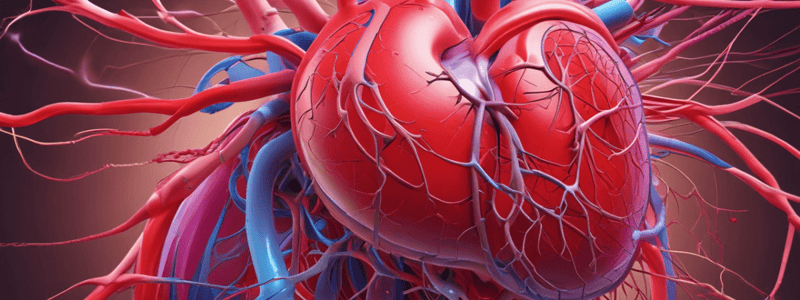Podcast
Questions and Answers
What is the driving force for blood flow?
What is the driving force for blood flow?
- The resistance of the vessel to blood flow
- The radius of the blood vessel
- The viscosity of the blood
- The pressure difference between the two ends of the vessel (correct)
According to the Poiseuille equation, which factor has the greatest effect on vascular resistance?
According to the Poiseuille equation, which factor has the greatest effect on vascular resistance?
- Blood viscosity
- Length of the blood vessel
- Radius of the blood vessel (correct)
- Pressure difference
What is the relationship between vascular resistance and blood flow?
What is the relationship between vascular resistance and blood flow?
- Decreasing resistance increases flow (correct)
- Resistance and flow are directly proportional
- Resistance and flow are unrelated
- Increasing resistance increases flow
What is the direction of blood flow determined by?
What is the direction of blood flow determined by?
What is the major mechanism for changing blood flow in the cardiovascular system?
What is the major mechanism for changing blood flow in the cardiovascular system?
What is the average pressure in the aorta?
What is the average pressure in the aorta?
What is the primary function of veins in the circulatory system?
What is the primary function of veins in the circulatory system?
Which factor is directly proportional to the resistance to blood flow?
Which factor is directly proportional to the resistance to blood flow?
Which of the following statements about vein compliance is correct?
Which of the following statements about vein compliance is correct?
What happens to blood distribution when veins constrict?
What happens to blood distribution when veins constrict?
If the radius of a blood vessel decreases by half, how does the resistance change?
If the radius of a blood vessel decreases by half, how does the resistance change?
What is the relationship between the arrangement of blood vessels and the total resistance to blood flow?
What is the relationship between the arrangement of blood vessels and the total resistance to blood flow?
What is the purpose of valves in veins?
What is the purpose of valves in veins?
What is the formula for calculating the resistance to blood flow?
What is the formula for calculating the resistance to blood flow?
Which factor contributes to the large blood storage capacity of the venous system?
Which factor contributes to the large blood storage capacity of the venous system?
How does the velocity of blood flow in veins compare to arteries?
How does the velocity of blood flow in veins compare to arteries?
What is the purpose of the parallel arrangement of blood vessels in the systemic circulation?
What is the purpose of the parallel arrangement of blood vessels in the systemic circulation?
What is the relationship between cardiac output, blood pressure, and total peripheral resistance?
What is the relationship between cardiac output, blood pressure, and total peripheral resistance?
What happens to the velocity of blood flow as the systemic arteries branch into smaller vessels?
What happens to the velocity of blood flow as the systemic arteries branch into smaller vessels?
Which of the following statements is true regarding the cross-sectional area of blood vessels?
Which of the following statements is true regarding the cross-sectional area of blood vessels?
What happens to the velocity of blood flow as it moves from arterioles to capillaries?
What happens to the velocity of blood flow as it moves from arterioles to capillaries?
How does the velocity of blood flow relate to the total cross-sectional area of blood vessels?
How does the velocity of blood flow relate to the total cross-sectional area of blood vessels?
What is the purpose of the slower blood flow velocity in capillaries?
What is the purpose of the slower blood flow velocity in capillaries?
Which of the following statements is correct about the relationship between blood flow and cross-sectional area?
Which of the following statements is correct about the relationship between blood flow and cross-sectional area?
What is the primary function of the systemic circulation?
What is the primary function of the systemic circulation?
Which artery has the highest compliance in the systemic circulation?
Which artery has the highest compliance in the systemic circulation?
What is the primary function of arterioles in the circulatory system?
What is the primary function of arterioles in the circulatory system?
Which receptor is predominant in arterioles of most visceral organs?
Which receptor is predominant in arterioles of most visceral organs?
What is the primary endogenous agonist at beta 2 adrenergic receptors in arterioles?
What is the primary endogenous agonist at beta 2 adrenergic receptors in arterioles?
How do lipid-soluble substances cross the capillary wall?
How do lipid-soluble substances cross the capillary wall?
What is the role of venules in the circulatory system?
What is the role of venules in the circulatory system?
Where is vascular resistance highest in the circulatory system?
Where is vascular resistance highest in the circulatory system?




